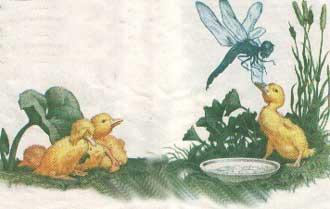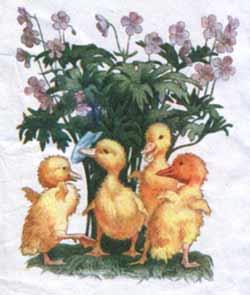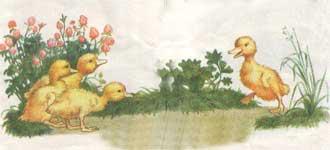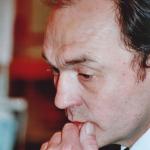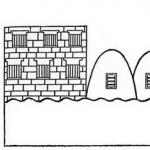Topic: plan and retelling of B. Zhitkov’s fairy tale “ Brave duckling».
Target : create conditions for developing the ability to draw up a plan and retell the text according to the plan.
Tasks:
1. educational : practice the skill of conscious reading; learn to answer questions, make statements with elements of reasoning; highlight semantic units of text.
2. developing: develop speech skills, expressive reading skills, abilityuse different types of reading: silently, aloud, buzzing reading.
3. correctional : develop auditory perception, oral speech students; enrich your vocabulary.
4. educational : contribute to the formation of an adequate self-assessment of one’s activities in the classroom; cultivate feelings of mutual assistance and friendship.
Lesson type: combined
M Methods: verbal, visual, practical, partially search.Forms of work organization: frontal, individual, steam room.
Lesson structure:
1.Organizational moment, setting goals and objectives for the lesson.
6. Lesson summary.
PROGRESS OF THE LESSON
Organizational moment, setting goals and objectives of the lesson.
1. It’s very important for us, guys (read by the teacher)
Fine … be able to read. (children add)
And even more important, children, (teacher reads)
I read that - … understand! (children add)
Well, in order to understand everything, (teacher reads)
Need to … think, reason, (children add)
Be attentive, diligent (teacher reads)
AND … help each other! (children add)
What will we do in class?
understand
think
reason
help each other
In order to read well, we need a warm-up:
we read in chorus, line by line - girls, boys (quietly-loudly)
2.Speech warm-up
Shi-shi-shi, shi-shi-shi,
The reeds are whispering something.
She-she-she, she-she-she,
This is a duck in the reeds.
2. Updating knowledge. Checking homework.
What work did we learn about in the last lesson? "Brave Duckling"(open note on the board)
What was the homework? ( read, answer questions)
Let’s check how you coped with it by playing the game “I want to ask a question...” Children ask questions to each other (I want to ask a question... reads out the question. The one to whom the question was asked reads out the answer. Evaluation. (Did you complete the task?! ). The one who read the answer asks the next person a question, etc.
1.
How did the housewife feed the ducklings?
(Students find a sentence in the text and answer.)
- Every morning the hostess brought out a full plate of chopped eggs.
2. Why were the ducklings afraid of the dragonfly?
- The ducklings were afraid that the dragonfly would bite them all.
3.How did the dragonfly behave?
(Students answer with words from the text.)
She chirped so terribly. She sat on the plate, tasted the food, and then flew away.
4.What was the hostess thinking about when she cleared away the empty plate?
- Our ducklings must be sick, they are not eating anything.
(Students find the answer in the text and read.)
5.Who came to visit the ducklings?
- One day, their neighbor, the little duckling Alyosha, came to visit the ducklings.
6. – What did he promise them?
- I alone will drive away this dragonfly. You'll see tomorrow.
7. -What did the ducklings answer?
8.Did he keep his promise? How did he do it?
- Before the dragonfly had time to sit on the plate, Alyosha grabbed its wing with his beak.
9.–Has the dragonfly arrived again?
- Since then, she never flew into the garden, and the ducklings ate their fill every day.
10. -How did the ducklings thank Alyosha?
They not only ate themselves, but also treated the brave Alyosha for saving them from the dragonfly.
Everyone completed their homework! Well done!
3. Presentation of new material.
Remember the name of the section we are working on now?
(plan and retelling)(open the card on the board)
Neither building a house nor the path of a captain
It won't work if you do them without a plan.
Be like a builder and like a captain:
When you get ready for business, think about a plan!
What are we going to do? (learn to make a plan and retell)
Now you have some very interesting work to do. I suggest working in pairs.
(envelopes with cards, glue, sheets of paper)
1.-Take out the picture cards from the envelope. What are these pictures?
Arrange the illustrations according to the content of the story. What happened first, what happened next. How did it all end? (children’s practical activities). Don't forget to check the text.
Examination. (open the finished picture plan). Who also? Put!
What did we get? (Plan)The plan is summary text.
Which? (picture) (plate)
Take out the word cards from the envelope. These are the headings of parts of the text.
Place the headings of the text parts next to the pictures in the required order.
(practical activities of children). Don't forget to check the text.
Examination.
What headline did you put first? (card on the board)
Second? Etc.
Plan:
1. The housewife feeds the ducklings.
2. Ducklings are afraid of dragonflies.
3. “The ducklings must be sick.”
4. Alyosha’s conversation with the ducklings.
5. Alyosha drives away the dragonfly.
6. The dragonfly didn’t come again.
Whoever managed it, put it!
What happened? (verbal plan) (card)
(correlation of pictures and titles)
4. Comprehension, generalization and systematization of knowledge.
You have two plans. What are their similarities? (same number of parts; sequence of events)
What's the difference? (in pictorial terms - illustrations, and in verbal terms - headings)
Which plan do you think is the most convenient? Why?
Why do you need a plan? (to make it easier to retell the text)
Physical education minute.
Now we will select an excerpt from the text for each point of the plan. (for the weak, ready-made cards with text - they need to choose a passage)
Frontal work.
Which passage should we select for part 1? Read...
How does the second part begin?
Find the passage for the third part.
Read….
Exercise for the eyes.
Why do we need a plan? For retelling. Try to retell the fairy tale to each other in pairs. (Children retell)
Who thinks that the neighbor's story was good? Give it to your neighbor!
Who will retell the whole fairy tale for us according to pictures and words? (retelling by one student)
(Evaluation)
5. Setting homework.
Prepare a retelling of the text according to plan.
6. Lesson summary.
Topic: B.S. Zhitkov. "Brave Duckling"
Lesson objectives: to acquaint children with the works of B.S. Zhitkova; timesdevelop expressive reading skills; learn to divide text intosemantic parts, draw up a picture plan; bring uplove of nature, careful attitude to animals.
Lesson progress
I. Organizational moment
II. Checking homework
Retelling of the text by E. Charushin “A Scary Story.” III . Learning new material. Setting a lesson goal
1. Teacher's story.
Boris Stepanovich Zhitkov traveled halfway around the world - Russia, EvRopu, Asia, Japanese Islands. He spoke fluentlydifferent languages, played the violin superbly and was a skilled musiciansyringer. I put all my experience, knowledge and talent into books,creating in children's literature new genre, who subsequently receivedThe name of the scientific and artistic. He wrote about the brave proud, selfless people, about rare animals and distant countries.
Zhitkov created about two hundred works and among them - amazing book “What I Saw”. Her hero is a four-year-oldboy Alyosha. The writer tells the children about everything he saw during his exciting summer adventures. By volume this book is not less romance. According to the diversity of prisoners it contains information - an encyclopedia. But it is written so interestinglyand it’s exciting that the guys listen to her with great interest. Several generations of children were brought up on the books of Boris Stepanovich Zhitkov, which teach goodness and the best human qualities.
Today in class we will get acquainted with Boris's story
Stepanovich Zhitkov "The Brave Duckling".
2. Preparatory work.
Read first syllable by syllable, then in whole words:
rub-le-nyh - chopped str-ko-ta-la - chirpedras-sk-za-li - toldyou're freaking out - you'll get scaredzhuzh-zha-la - buzzedin a lo-man-nym - broken
3. Primary reading.
Children read the story in a chain.
4. Checking your understanding of the content and meaning of the story.
- Did you like the story?
What is the story about?
- How did the housewife feed the ducklings?
- Why didn't the ducklings eat? Who were they afraid of?
- Why were the ducklings afraid of the dragonfly?
- What was the hostess thinking about when she cleared away the empty plate?
- Who came to visit the ducklings?
- What did he promise them? Did he keep his promise?
- How did he do it?
- How do you understand the expression “forcefully escaped”?
- Did the dragonfly come again?
IV. Physical education minute
V. Consolidating new material
1. Expressive reading.
2. Drawing up a picture plan.
- Let's draw an illustration for each episode of the races tale
- Where does the story begin? (The housewife feeds her ducklings.)
- What illustration can you draw for this episode?
- Why didn't the ducklings eat? (They were afraid of dragonflies.)
- How did they behave? What can you draw? (They were afraid and right lurked in the grass.)
- Why was the hostess surprised? What illustration should we draw?
- Who comes to visit them? What illustration should we draw? (Alyosha's conversation with the ducklings.)
- What's the next episode? (Alyosha chases away the dragonfly.)
- How do we depict this?
- How does the story end? What can you draw for this?episode? (Satisfied ducklings eat and treat Alyosha.)
3. Children draw illustrations for the story.
VI. Lesson summary
- What story did you read today?
- Is it possible to call the story of B.S. Zhitkova fairy tale? Why do you think so?
- What can you say about the duckling Alyosha? What is he like?
- Should the ducklings be afraid of the dragonfly? Why?
Homework
Prepare a retelling according to the picture plan. (If the children in the class did not have time to complete the drawing, they complete the illustration at home.)
State educational institution Education Center No. 1428
Lesson summary on literary reading
for 2nd grade
using ICT
teachers primary classes GOU TsO No. 1428
Gumbatova Vera Alexandrovna
Subject: B.S. Zhitkov “The Brave Duckling”.
Target: introduce children to the writer’s work and the content of this story.
Tasks:
Educational: the formation of a full perception of the text,
learn to divide the text into semantic parts and title them;
draw a word picture for each part
and make a retelling plan.
Developmental: develop meta-subject and communicative skills
universal actions, develop skills
expressive reading;
work on the development of speech, memory, thinking,
imagination;
Educational: cultivate interest in lessons literary reading,
love and respect for nature,
cultivate feelings of compassion and empathy.
Technical support:
Teacher's workstation
Multimedia projector
Interactive whiteboard
Software:
Operating system Windows XP
Microsoft Office
Presentation:
Portrait of the writer B.S. Zhitkov
Speech Box
Vocabulary work
Read in whole words
Making a plan
equipment:
soft toys: duck with duckling, dragonfly, basket with 16 kinder surprises; colored caps – 3 pieces
(under them there is a plate, a bird, a girl - small toys): an exhibition of books by B. Zhitkov: 3 colored envelopes (red, blue, yellow) with a task for working in groups, a musical physical education session.
Progress of the lesson.
I. Organizational moment.Greeting guests.
II. Repetition of what has been learned.
1. Conversation.
Let's remember what is the name of the section we are working on now in literary reading lessons?
(About our smaller brothers).
Explain the title of the section.
What works are included in this section?
Why do we call animals “Little Brothers”?
What do writers make us think about and what do they advise? (N.I.Sladkov. “Do no harm!”
N.I. Sladkov wrote: (reading a passage by heart) “Nature tests you for peacefulness. Flowers whisper about this, birds call to each other. The animals deliberately catch your eye - how will you behave?... The birds call out - what will you do?...
Will you stop, look, listen - or grab a stick or stone? And then they will decide how to treat you.
As you do, so to you!
Only our love can save nature!
And we know that animals are part of nature.So, we continue to work on this section.
2. Getting to know the heroes of the fairy tale.
Now let’s get acquainted with the heroes who will accompany us in the lesson.
But first, guess who they are?
a) Riddle.
On the daisy at the gate
The helicopter descended -
Golden eyes
Who is this? (dragonfly)
What do you know about her?
In which work did you meet a dragonfly? (Krylov’s fable “The Dragonfly and the Ant”)
How is it presented by I.A. Krylov? (lazy, careless, carefree)
What does she eat?
What is a dragonfly really like? (dragonfly toy)
The dragonfly is a good flying insect. With a movable head, large eyes, an elongated abdomen, 4 transparent wings, and antennae. They live mainly in stagnant waters: lakes, ponds. Dragonflies feed on insects, grabbing prey on the fly. By exterminating mosquitoes, midges and other harmful insects it is beneficial. Each dragonfly has its own territory on which it feeds, protects it from other dragonflies and, if necessary, fights for it. They are called watchmen. Some species of dragonflies in the Russian region are listed in the Red Book.
Who is the second hero?
Mystery.
Quack-quack! Here! Here!
Sounds out from the pond
That's what he calls his little one
Mallard, in other words... (duck)
What do you know about her? (duck toy)
In what work did you meet her? (M.M. Prishvin. Guys and ducklings.)
How did M.M. Prishvin present it in his work? (Caring, loving, attentive).
c) Riddle.
Amazing child
Just got out of diapers
Can swim and dive
Like his own mother. (Duckling)
Why did they say duckling? (duckling toy)
How is he born?
What do ducklings feed when they are little? (egg)
Why do they say “crushed the egg”?
Did you have to feed and care for them?
3. Didactic game"Guess the correct name for baby pets."
You correctly named the baby ducks - ducklings, but do you know the correct names for other baby animals?
If I'm right, clap your hands.
The cat has a kitten,
The dog has a little dog, (puppy)
The hare has a bunny,
The duck has a duckling,
The ewe has a sheep (lamb)
The hen has a chicken (chicken)
A hedgehog has a hedgehog.
The cow has a little cow (calf)
The pig has a little pig (piglet)
The fox has a little fox,
The fish has a little fish (fry)
The moose has a calf.
The she-wolf has a wolf cub.
The dove has a baby dove (chick)
III. Summarizing and communicating the topic.
1. On the table in front of the board there are toys 6 dragonfly, duck and duckling.
So, our guests are a dragonfly and a duckling. We are ready to tell you interesting story which once happened to them. and which I composed for you famous writer Boris Stepanovich Zhitkov.
Physical education lesson No. 1.
In the morning the dragonfly woke up. Three - she stepped and sat down,She stretched and smiled. At four, it flew.
Once, I washed my face with dew. Stopped by the river -
Two - she spun gracefully. Spun over the water.
IV.Study new topic.
Exhibition of books by B. Zhitkov.
Biography of B.S. Zhitkov. (slide No. 1 - portrait)
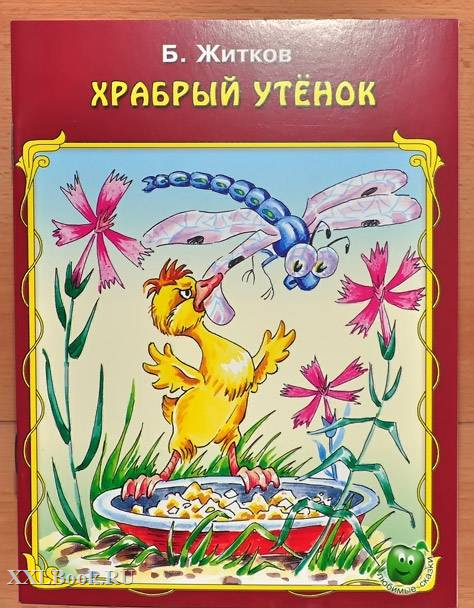
Boris Stepanovich Zhitkov was born on September 11 in Novgorod, into the family of a mathematics teacher and pianist. He received primary education at home and an excellent family upbringing. He studied at the Odessa gymnasium and was a classmate of K.I. Chukovsky. by education he is a biologist and chemist, a shipbuilding engineer. He worked as a cabin boy, navigator, captain of a research vessel, and ichthyologist - studying fish. He taught drawing and physics.
A man of encyclopedic knowledge, about whom friends spoke like this: “He willingly served as a living reference for us. He seemed to know absolutely everything. Crafts, tools, technical terms, stars, rivers, lakes, animals, insects. Pisces, how things are done, where things happen..."
BS.Zhitkov was fluent in many European languages and traveled a lot. The richest life experience, the ability to interestingly and accurately express his thoughts on paper led B.S. Zhitkov to children's literature.
Look at the exhibition of books by B.S. Zhitkov, all of them are dedicated to children. They published marine
stories, fairy tales, popular science and scientific works. In total, Zhitkov created about 200 works. You can take all these books from the school library and read them.
He wrote about proud and brave, selfless people, about rare animals and distant countries. Among them is an amazing book - “What did I see?” her hero is 4 year old boy Alyosha. The writer told the children about everything he saw during his exciting summer adventures. It is written so interestingly and excitingly that people listen and read it with great interest. Books by B.S. Zhitkov teach goodness and the best human qualities.
And today we will get acquainted with one of B.S. Zhitkov’s stories from this book.
2.Working with the textbook.
Open the textbook on p.
Read the name of the story we will be working on. (B.S. Zhitkov. Brave duckling.)
Try to guess what the story will be about? (children's statements0
We'll check it out soon. Are your assumptions correct?
But first...
3. Preparatory work for reading. (slide No. 2 - chest) 
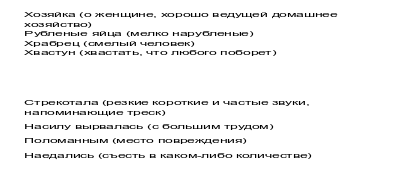
a) what do you see? (box)
Explain lexical meaning words.
A chest is a box with a lid, hinges and locks. For storing things. In the old days, clothes and linen were folded into it, because... there were no closets like we have now.
But how can it be called by another word, if it is a small chest for storing jewelry. (casket)
You probably thought, why do we need a chest or casket, because we are now having a literary reading lesson.
b) vocabulary work(slide No. 2a)
This casket is unusual.
What is it called?
Hidden inside it are the words from our story. Now we will extract them from there and explain the meaning of the word in order to better understand the content of the story.
Housewife - about a woman who runs a good household.
Chopped eggs – finely chopped.
A brave man is a brave man.
A braggart - he boasts that he can beat anyone.
Chirped - sharp, short, frequent sounds, reminiscent of crackling.
I broke free with great difficulty, overcoming difficulties.
Broken – place of damage.
Eaten up - to be full.
c) reading words in whole words (slide No. 3) 
Now let’s practice reading the words that will appear in Zhitkov’s story “The Brave Duckling.”
Student - in chorus.
Running - they ran up, ran away.
Story - told
Fright - you will be frightened, frightened.
Biting - he will have a snack, bite.
Food - we were full. We didn't eat enough.
4. Initial acquaintance with the text by B.S. Zhitkov “The Brave Duckling”.
Children read the story in a chain.
Physical education lesson No. 2. Musical for the eyes “Dragonfly”
5. Conversation on the content and understanding of the meaning of the story “The Brave Duckling”.Were your assumptions justified? What is the story about?
How was the housewife and what did she feed the ducklings?
Why didn't the ducklings eat? Who were they afraid of and why?
What was the hostess thinking about when she cleared away the empty plate?
Who came to visit the ducklings?
What did he promise them and did he keep his promise?
Did the dragonfly come again?
Should the ducklings be afraid of the dragonfly? Find the lines in the text and read. (And the evil dragonfly... and then flew away)
What can you say about the duckling Alyosha? What is he like?
Can B. Zhitkov’s story be called a fairy tale and why do you think so?
V. Consolidation of the studied material.
1. Reading the text in parts and naming it, drawing a verbal illustration.
Where does the story begin?
What illustration would you draw for part 1?
How do you title 1 hour?
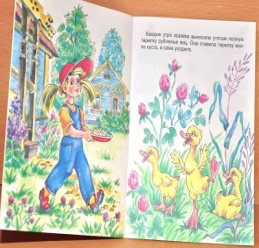
The housewife feeds the ducklings.
2h.Why didn't the ducklings eat?
What illustration would you draw by 2 o'clock?
How do you title 2 hours?
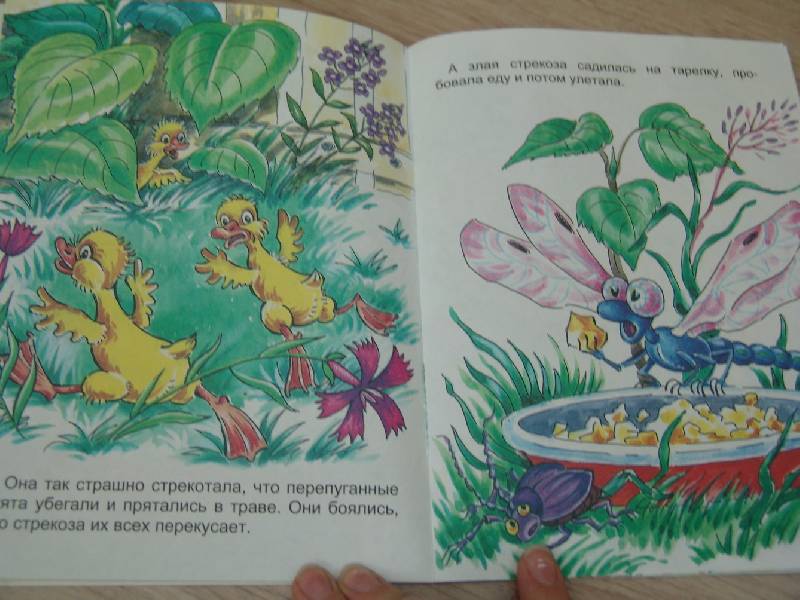
Ducklings are afraid of dragonflies.
3 hours
Why was the hostess surprised?What illustration would you have drawn by 3 o'clock?
How do you title 3 hours? 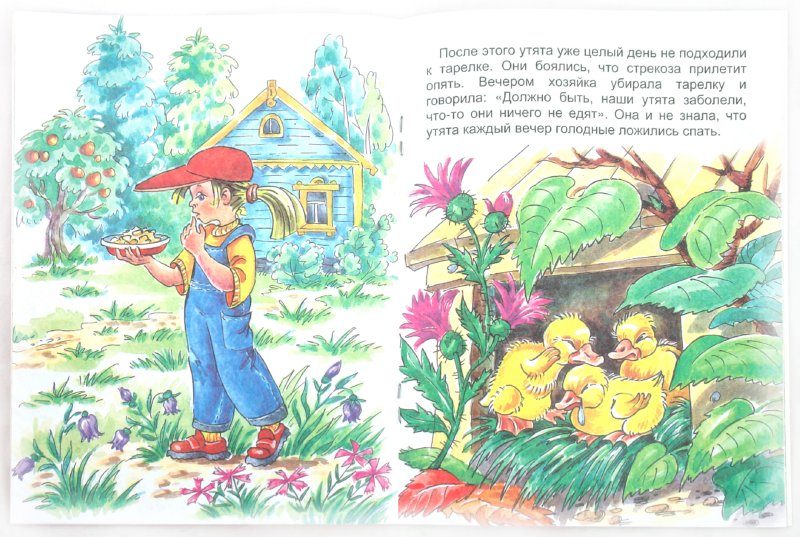
The hostess's surprise.
4 hours
Who came to visit them?What happened between them?
What illustration would you have drawn by 4 o'clock?
How do you title 4 hours? Alyosha's conversation with the ducklings.
5 hours
What happened?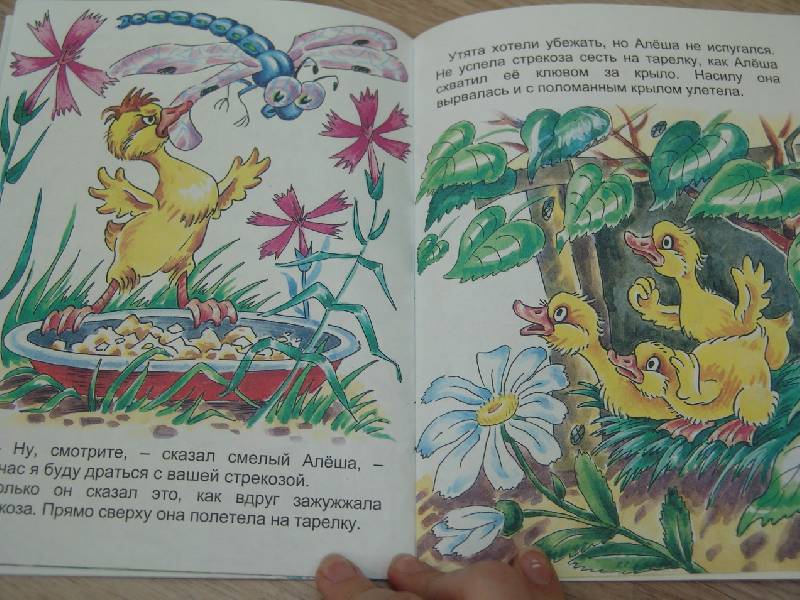
What illustration would you have drawn by 5 o'clock?
How do you title 5 hours? Alyosha chases away the dragonfly
6 hours
How does the story end?How do ducklings feel?
What illustration would you have drawn by 6 o'clock?
How do you title 6 hours?  Satisfied ducklings.
Satisfied ducklings.
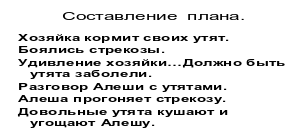 2. Work in groups.
2. Work in groups.
Assignments in envelopes of different colors.
1 group.
Assignment: restore the text from individual parts and select an illustration for each part.
(The outline of the text is cut into parts and illustrations.There is a green cap on the table, and under it is a bird. Determine which part of the text the bird belongs to and guess the riddle.
2nd group.
Task: restore the outline of the text in the required sequence.
The plan is cut into separate strips.(There is a red cap on the table, and under it there is a figurine of the hostess. Describe the hostess.)
3rd group.
Assignment: collect proverbs and choose a proverb that fits our story.
Proverbs are connected using arrows.(There is a yellow cap on the table, and under it there is a plate and a dragonfly. What do they mean in our story)
3. Checking work in groups. (slides No. 4-9)
VI. Lesson summary.
What was the name of B. Zhitkov’s story? What does this story teach us?How do you think the writer treats animals?
What proverb can we end our lesson with? (Support each other, win.)
6. D/Z. You found objects on the table under colored caps.
What are these items?
Who is the odd one out that we didn’t meet in our story? (birdie)
Our guests - the dragonfly and the duckling - thank you for the lesson and have prepared a surprise for you.
There is a kinder surprise in the basket. Children close their eyes and take out a surprise.
At home, find out what the item is in your kinder surprise and make up a story, but instead of Alyosha the duckling, make your own hero from an egg.
Topic: Boris Stepanovich Zhitkov “The Brave Duckling”.
Objective of the lesson: create conditions for familiarization with the work of B. Zhitkov and a new work.
Tasks:
Educational: organize the perception and comprehension of the text by students.
developing:- develop expressive reading skills, determine the sequence of events, draw up a plan, retell in detail according to the plan.
raising:- to promote in children a sense of compassion, pity for the weak, and instill a sense of caring for them;
Promote a tolerant attitude between children and unity of the class team;
To instill in students an awareness of the values of friendship, support and mutual assistance;
Planned educational results:
Subject: will learn: perceive what is read by ear, use different types of reading, identify the heroes of works, characterize them; express your own attitude towards the characters; give a moral assessment to the actions of the heroes.
Metasubject: educational: master the skills of semantic reading, choose the type of reading depending on the purpose, master the actions of comparison, generalization; regulatory: form and maintain a learning task, anticipate the result; communicative: adequately assess their own behavior and the behavior of others, evaluate their response, provide mutual assistance in cooperation, readiness to listen to their interlocutor and engage in dialogue.
Methods and forms of training: Shapes: frontal, individual. Methods: verbal, visual, practical.
Equipment: computer, presentation, cards, audio recording, physical education,
Textbook: L.F. Klimanova Literary reading. 2nd grade.
Lesson type: a lesson in learning and consolidating new material.
Progress of the lesson.
I. Organizational moment.
Teacher.
They looked at each other,
They smiled and sat down quietly.
Teacher: And we will work in class under the motto, let’s read it together:
Lesson motto: (Slide 1.)
In a book, look not for letters, but for thoughts..
II. Setting the goals and objectives of the lesson.
Teacher.– We begin to work and be surprised by what we read.
Checking homework.
And for this we will solve a riddle...
Here are the needles and pins
They crawl out from under the bench.
They look at me
They want milk.
And who is this? (Hedgehog)
In what story did we meet this hero? (“Scary story”
Now let's conduct game "Yes-no"
If it’s correct, we put +, and if not, then - (Task No. 1)
Each task on the card is evaluated 1 point
The boys' names were Petya and Shura? (Yes)
Couldn't the children sleep without mom and dad? (Yes)
Were cockroaches crawling along the wall? (No)
Is there a hedgehog curled up in the corner? (Yes)
Did the children give him apples? (No)
Did the hedgehog live all summer? (Yes)
Now let's check. ( Slide number 2) Self-esteem.
Teacher. If you answered all the questions, give 1 point.
(Work in pairs). - Teacher. Well done. We completed this task. But these are not all the tests you need to pass. Now we will continue to work in pairs. Just imagine, while our hedgehog was scaring the boys, the authors and their works got mixed up on a shelf in the house. To do this, take cards that say task 2. Connect the author of the work with the title of the work he wrote with an arrow.
| "Cat Puppy" |
|
| V. Berestov | "A Scary Story" |
| B. Zhitkov | "Once upon a time there was a dog" |
| I. Pivovarova | "Brave Duckling" |
Teacher.- Let's check. “Cat Puppy” - (V. Berestov .(Slide 3).
Teacher.- “A scary story”...? .(Charushin).
Teacher. – Poem “Once upon a time there was a dog.” (Irina Pivovarova).
Teacher: What unites all these works? (about animals)
Teacher. - Which work is unfamiliar to us? (“Brave Duckling.”) (Slide 4)
Teacher.- Without reading, let's guess what we learn about in this story? To do this, words will help you, read these words and say what the content is. (Slide 4)
Duckling yard mistress ran away
Ducklings food plate scared
Teacher. – But we’ll find out later whether your assumptions are correct.
But now, before reading, let’s define for ourselves the tasks for the lesson, using key words: reception “Speculation” (Slide 5)- Let's get to know each other... (with biography of B. S. Zhitkov and story).- Let's study ..(read expressively the work “The Brave Duckling”).- Analyze ... (Heroes and their actions) Teacher.-That's right, we We will read the story, identify the main characters, describe their character and behavior.
111 Studying a new lesson topic.
1. A story about the work of B. S. Zhitkov. Teacher. – We know what work we will read. And now we are starting to get acquainted with the writer’s work, and you will help me. (Slide 6)
Creation of the “Cluster”:\Appendix 1\
Name the professions that the writer mastered? (He was a fisherman, a hunter, a ship builder, he was a captain and an animal trainer)
Name Zhitkov’s stories (“About an Elephant”, etc.),
Teacher. Zhitkov wrote about animals, as well as about people of different professions. Zhitkov's heroes often find themselves in extreme situations. You can learn all this from the books that we have at the exhibition. (Slide 7). If you are interested in Zhitkov’s stories, you can borrow them from our school library . [ 2 ] \Appendix2\
Teacher. Well done, you helped me a lot and learned a lot about the writer. Now complete task 3. Look, guests have come to us, and now we will find out who they are. To do this, solve riddles.
Bright mini helicopter
Takes flight.
But why does he need eyes?
Yes, he’s just...(dragonfly)
Fluffy sailor
Spout with a spatula
On short legs -
Red shoes. (Duckling)
\Appendix 3\
- Teacher. -Let's check your answers. Name the heroes of our work. (Dragonfly, duckling) (Slide 8)
Teacher. So, we know who came to visit us. Let's start getting acquainted with the heroes, but for this, let our eyes rest.
Exercise for the eyes.(Slide 9). Vocabulary work.
Teacher. - To better understand the content of the story, explain the meaning of difficult words. (Slide 9)
Mistress(about a woman who has order everywhere.)
Chopped eggs(finely chopped.)
Brave(courageous and decisive, brave.)
Chirped(sounds like crackling.)
Teacher.- Well done! So, the dragonfly and duckling are ready to tell you an interesting story. And this story happened to them one day. And it was written by the famous writer Boris Stepanovich Zhitkov.
3.Working with the textbook .
Teacher. - Now you will listen to the piece. And after reading, we will check whether your assumptions are confirmed.
(Listening to audio recording Slide No. 10)
Teacher. Well, now tell me, did what you heard confirm your assumptions? (Indeed, this story is about a brave duckling.) Teacher. – What didn’t you expect? (That a duckling can do this.) ( Teacher.- What feelings did you experience while listening to the work? (excitement) Teacher.- Why? ( worried about the ducklings and the duckling) Teacher. In the story, there are difficult words to read. To make it easier for you to read, we will read the words syllable by syllable. (Read in chorus).(Slide 13)
rub-le-nykh –
str-ko-ta-la –
ras-sk-za-za-li –
is-pu-ga-e-sya –
zhuzh-zha-la –
in a lo-man-nym -
Reading the text in parts, table of contents for each part, discussion.
Teacher. What should we title this part? (“Feeding”. Slide No. 13) \ Appendix 4 \
Tell me, how did the housewife feed the ducklings? (put down the plate and left)
Teacher. What title should we give this part? (“Evil Dragonfly” Slide No. 14)-Answer, who were the ducklings afraid of? (Dragonfly) \Appendix5\
Why were they afraid of her? (She chirped)
Teacher. What's the title of this part? (“Promise”. Slide No. 15)
Who came to visit the ducklings? (Duckling)
What did he promise them? (Promised to drive away the dragonfly)
Teacher. Let's title the next part. (“Salvation.” Slide No. 16) \Appendix 7\
Did Alyosha fulfill his promise? (Yes)
How did he do it? (Alyosha grabbed her wing with his beak).
Teacher. Title the part. (“Gratitude.” Slide No. 17)
Did the dragonfly visit them again? (She has never flown since then)
Checking your understanding of the content and meaning of the story you read.1. Conversation.
Teacher.- Did you like the work? - Which episode did you like best? And why. - Do you think Alyosha the duckling did the right thing by standing up for the ducklings? (Yes)
(Work with cards)
Teacher. Yes, We liked the work and especially the characters. Now complete task 4. Let's describe the duckling Alyosha and the dragonfly, using words and connecting with arrows - 1 point
Duckling
(Brave, bold, kept his promise, keeps his word.
Dragonfly
Evil, gluttonous, impudent
Teacher. Let's check. (Slide 18) So which hero do you like best and why?
Teacher. Let's try to name B. Zhitkov's work by genre. Do you think this is a story or a fairy tale? (Yes, this is a fairy tale)
What fairytale element is present in this work? ( Heroes are talking)
Teacher.– And as our heroes say, our heroine dragonfly invites you to exercise.
Fizminutka [ 11
Consolidation of the studied material.
A) Individual work with the card.
Teacher.- We rested. And now our heroes want to check whether you were paying attention when you read. And they offer you to complete an interesting task. You each have card number 5 on your tables. Match the headings of the text and the pictures by connecting with an arrow in the correct sequence the events occurring in the story.
| 1. 2 3.
5. | The housewife feeds the ducklings. Ducklings are afraid of dragonflies. The duckling's bold promise. Alyosha chases away the dragonfly. A treat for the savior. |
B) Checking implementation.
Teacher. Let's check it out. ( Correct answer.Slide No. 19)
Teacher.– Please note that we have two plans. One is verbal, and the second is pictorial. How are they similar? ( number of parts and events.)
Teacher.- How do they differ? ? ( illustrations, headings.)
Teacher.- Which plan is more convenient for you? Why? ( Picture-sequential).
Teacher.- Well done. So what is a plan for? ( retell the text).
Teacher. Well, now let’s try to retell our fairy tale according to the picture plan. (Retelling)
Selective reading
Teacher- Well done. We did it too. Now find and read the episode about how the ducklings were scared of the dragonfly.
Teacher.– Find the passage where Alyosha made a promise to the little ducklings.
Teacher. - How many characters are there in this episode? . – (Author, little duckling Alyosha, and ducklings.)
Teacher.- What is the intonation when reading the words of Alyosha the duckling? (Bold, important)
Teacher.- How can we read the ducklings’ words? (Frightened.)
Teacher.– We will now read this passage in person. You will read the words of the ducklings, and the words of the author will be the teacher.
(Reading in faces)
Teacher.-We completed this task too. Listen and tell me who this is?
Here's a dragonfly
Like pea eyes.
The local people were scared
Only one brave man remained.
Teacher. – Who is this brave man? (- Duckling.)
Teacher.– Find a passage that confirms the duckling’s victory?
Teacher. - Tell me how the ducklings thanked you. Alyosha?
C) Working with proverbs.
Teacher. – Well done guys! People came up with poems, sayings, and proverbs about courage and bravery.( Slide 20.)- Read the proverbs and explain how you understand them?
The brave man is recognized on the day of battle.
WHERE IS FEAR, THERE IS CORRUPTION.
Teacher. - Explain the word “collapse”? (Failure, failure.)
Teacher.- Which hero can the first proverb be related to? (To Alyosha the duckling.)
Teacher.- To whom can the second proverb be related? (.- Ducklings).
Teacher.- Why do you think so? (Because the ducklings were afraid and remained hungry)
Teacher. – Every person, and especially a child, can be afraid of something. Some people are afraid of big dogs. Others are afraid to stay home. And there are those who are afraid to answer in class. Overcoming fear, defeating it is very important for every person. Becoming brave means being able to overcome your fear.
So what is it main idea story? (We are not afraid. We overcome our fears. Help friends, stand up for the weak.)
Teacher.- Well done, you completed all the tasks. Let's count how many points each pair got. (Result)
Teacher. So what fairy tale did we read? (Brave Duckling)
V. Lesson summary. Reflection.
Who is the author story - fairy tale? (Boris Zhitkov)
- Should the ducklings be afraid of the dragonfly? (There was no need to be afraid of the dragonfly)
- What did you learn from Alyosha? (Help friends out of trouble and overcome your fears). Teacher. –A Now we will play with you. The game is called "Candle". We will stand up and pass the candle to each other with wishes for what a person should be.
Teacher. And to finish, continue the phrase.. (Slide 21)
Today in class I learned...
I thought it was interesting.
I was surprised…..
I want to praise ...., for ......
Teacher. Our heroes are very grateful to you for the lesson.
House. exercise . Open the diaries and write down the task . Page 139-141 retell the story.
1 http://nova.rambler.ru/search?query
2. http://go.mail.ru/search?q
3.http://nova.rambler.ru/search?query
4 vahnenko.ucoz.net/load/...
5 http://vseskazki.su/rasskazi-boris-zhitkov/khrabryj-utenok.html
6 http://go.mail.ru/search_images?gp
7,8.9,10=http://go.mail.ru/search_images?gp
11 http://wikibit.me/video/SAWr-KZhD0E
12.http://flaminguru.narod.ru/poslhrab.htm.
Application
1.
2.
3
4
5
6
7
8



